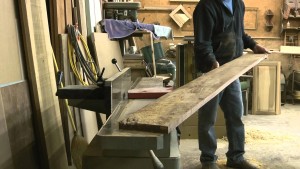 Print a Sign-In Sheet | Spanish Version
Print a Sign-In Sheet | Spanish Version
Edgers are used to straighten and smooth rough lumber and/or bowed stock by making a cut along the sides of the boards. The result of this process is a straight edge along the stock.
Where vertical arbor edger saws are located ahead of the main saw, guard the saws so that an employee cannot contact any part of the edger saw from his/her normal position.
Edgers should not be located in the main roll case behind the head saws.
The top and the openings in end and side frames of edgers must be adequately guarded, and gears and chains must be fully housed. Guards may be hinged or otherwise arranged to permit oiling and the removal of saws.
All edgers must be equipped with pressure feed rolls.
Provide edgers with safety fingers or other approved methods of preventing kickbacks. A properly fenced-off barricade, in line with the edger, may be used if safety fingers are not feasible to install.
If the operator is required to handle cants to straighten them, consider the following:
- Raise the end feed table to make it higher than the roller bar, and add adequate line bars with reversible chains.
- Use a system of pop-up pins to align cants.
- Install an adjustable fence.
- Use a line bar to straighten cants.
Important! There have been serious injuries to employees while cleaning or simply getting too close to the exposed underside of edgers. The exposed blades can catch on clothing and pull the worker into the blades, causing serious injury. Always take precautions when working near saw blades and moving parts. Always disconnect and lock out power sources when performing maintenance or placing any part of your body in an area where an injury could occur during an unexpected start-up.
KEMI does not assume liability for the content of information contained herein. Safety and health remain your responsibility. This information is to be used for informational purposes only and not intended to be exhaustive or a substitute for proper training, supervision, or manufacturers’ instructions/recommendations. KEMI, by publication of this information, does not assume liability for damage or injury arising from reliance upon it. Compliance with this information is not a guarantee or warranty that you will be in conformity with any laws or regulations nor does it ensure the absolute safety of any person, place, or object, including, but not limited to, you, your occupation, employees, customers, or place of business.

